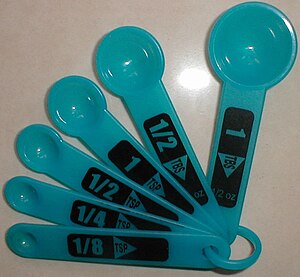

In recipes, quantities of ingredients may be specified by mass (commonly called weight), by volume, or by count.
For most of history, most cookbooks did not specify quantities precisely, instead talking of "a nice leg of spring lamb", a "cupful" of lentils, a piece of butter "the size of a small apricot", and "sufficient" salt.[1] Informal measurements such as a "pinch", a "drop", or a "hint" (soupçon) continue to be used from time to time. In the US, Fannie Farmer introduced the more exact specification of quantities by volume in her 1896 Boston Cooking-School Cook Book.[2]
Today, most of the world prefers metric measurement by weight,[3] though the preference for volume measurements continues among home cooks in the United States[4][5] and the rest of North America. Different ingredients are measured in different ways:
Liquid ingredients are generally measured by volume worldwide.
Dry bulk ingredients, such as sugar and flour, are measured by weight in most of the world ("250 g flour"), and by volume in North America ("1⁄2 cup flour"). Small quantities of salt and spices are generally measured by volume worldwide, as few households have sufficiently precise balances to measure by weight.
In most countries, meat is described by weight or count: "a 2 kilogram chicken"; "four lamb chops".
Eggs are usually specified by count. Vegetables are usually specified by weight or occasionally by count, despite the inherent imprecision of counts given the variability in the size of vegetables.
- ^ Schofield, Mary Anne (1989). Cooking by the book: food in literature and culture. Bowling Green, OH: Bowling Green State University Popular Press. p. 8. ISBN 0-87972-443-9. Retrieved 2011-04-20.
An example is Lydia M. Child. The Frugal Housewife provides recipes of the "butter the size of a walnut, a good handful of sugar, bake until done" variety along with....
- ^ "Documents that Changed the World: The Fannie Farmer Cookbook, 1896". UW News. Retrieved 2024-03-17.
- ^ Pat Chapman (2007). India Food and Cooking: The Ultimate Book on Indian Cuisine. London: New Holland Publishers (UK) Ltd. p. 64. ISBN 978-1845376192. Retrieved 2014-11-20.
Most of the world uses the metric system to weigh and measure. This book puts metric first, followed by imperial because the US uses it (with slight modifications which need not concern us).
[permanent dead link] - ^ Gisslen, Wayne (2010). Professional Cooking, College Version. New York: Wiley. p. 107. ISBN 978-0-470-19752-3. Retrieved 2011-04-20.
The system of measurement used in the United States is complicated. Even when people have used the system all their lives, they still sometimes have trouble remembering things like how many fluid ounces are in a quart or how many feet are in a mile. ... The United States is the only major country that uses almost exclusively the complex system of measurement we have just described.
- ^ Lahey, Jim (2009). My Bread: The Revolutionary No-Work, No-Knead Method. W.W. Norton. p. 48. ISBN 978-0-393-06630-2.
Plenty, probably most, home cooks in America do their baking without the use of a kitchen scale, but measuring by weight is the norm in many other parts of the world, and certainly in professional bakeries. Weight measurements are crucial for precisely standardized results. When you measure only by volume, there is a lot of room for variance: a cup of flour can differ in amount, depending on how densely it's packed, but the weight will be accurate no matter what. So I've included the metric weights in this book for those who want to use them at home....